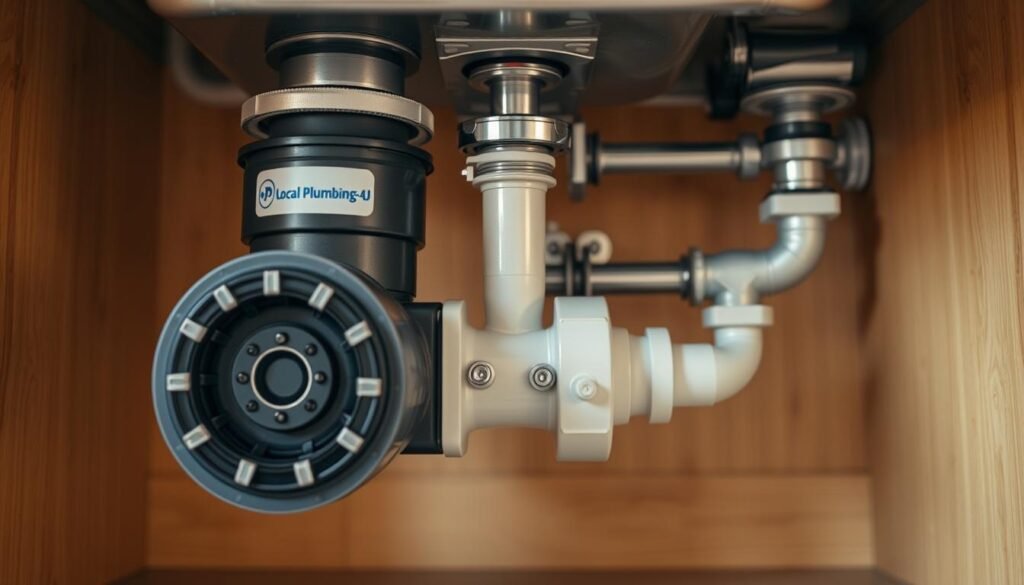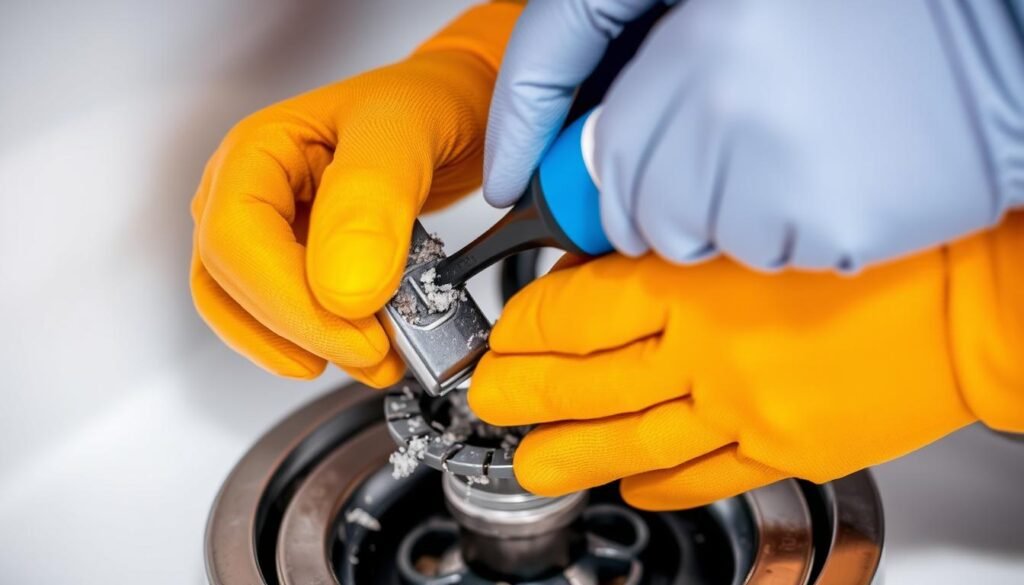Did you know that 30% of kitchen sink clogs are caused by bad food grinder use? Your kitchen’s hardest worker needs better care. With the right attention, your disposal can last 15+ years, saving you a lot of money.
Your sink’s grinder breaks down soft food waste for easy flow through pipes. Without care, blockages can form, leading to expensive fixes.
At Local Plumbers 4 U, we’ve seen many avoidable problems in Riverside County, San Bernardino, and Corona CA. Our experts suggest easy maintenance tips to keep your system working well for years.
To make your appliance last longer, know what to put down the drain. Using it right stops jams and motor problems. Regular cleaning also stops bad smells and buildup. For expert help with your kitchen, our team at Local Plumbers 4 U is ready to assist the Inland Empire.
Key Takeaways
- Regular maintenance can extend your disposal’s lifespan from 8-12 years to 15+ years
- Always run cold water before, during, and after operation
- Avoid putting fibrous foods, bones, and cooking oils down your disposal
- Use ice cubes and citrus peels for natural cleaning and odor control
- Professional maintenance once yearly prevents costly emergency repairs
- Proper care prevents common drain clogs throughout your home’s plumbing
Understanding Your Garbage Disposal
The garbage disposal under your sink is a key part of your kitchen. It grinds food waste, keeping it from landfills. Knowing how it works can help avoid plumbing problems and save money in the Inland Empire.
What is a Garbage Disposal?
A garbage disposal is an electric device under your sink. It shreds food waste into small pieces. These pieces then flow through your sink plumbing without clogging it.
At home, disposals keep your kitchen clean and odor-free. They also cut down on trash. In restaurants, they handle more waste, making kitchens run smoother.

A disposal has several parts: a motor, grinding chamber, and more. The motor powers the grinding mechanism to break down waste.
How Does it Work?
When you turn it on, the motor spins fast. This spins impellers that push waste against a grinding ring. The ring breaks it down. Water then flushes it through the drain.
Most homes have continuous or batch feed disposals. Continuous feed disposals run as long as you press the switch. Batch feed models need a stopper to start.
| Disposal Type | Operation Method | Safety Level | Best For |
|---|---|---|---|
| Continuous Feed | Operates while switch is on | Moderate | General household use |
| Batch Feed | Requires stopper activation | High | Homes with children |
| Commercial Grade | Continuous operation | Moderate | Restaurants, businesses |
Common Problems and Solutions
Even well-kept disposals can have problems. Knowing the common issues can help avoid bigger problems. Jamming is a common issue. Hard or fibrous items can get stuck, making the disposal hum but not work.
To fix a jam, turn off the power first. Then, use the hex wrench to rotate the flywheel from underneath. This usually clears the jam. After, check for a reset button before turning the power back on.
Clogged disposals are another problem. Water may back up into your sink. To fix it, avoid chemical cleaners. Instead, try a plunger or baking soda and vinegar followed by hot water.
Strange noises mean something like a spoon or bottle cap is stuck. Leaking disposals need professional help. Odors usually mean food is stuck in the disposal or pipe.
Proper maintenance is key to avoiding disposal problems. Running cold water before, during, and after use helps keep your plumbing system clear.
Commercial kitchens in the Inland Empire face unique disposal challenges. They need strong units that can handle more waste. Regular maintenance can prevent repairs and extend the unit’s life.
- Grinding noises: May indicate metal or hard objects in the chamber
- Humming but not running: Usually signals a jam requiring manual reset
- Water backing up: Points to a clogged disposal or drain pipe
- Leaking from bottom: Often indicates seal failure requiring replacement
- Persistent odors: Suggests food buildup needing thorough cleaning
Knowing about common issues helps you decide when to try to fix it yourself or call a pro. For serious problems, experts can save you time and prevent damage to your kitchen’s waste system.
Essential Maintenance Tips for Homeowners
Keeping your garbage disposal in top shape is key. It’s not just about avoiding clogs. It’s about making sure your kitchen runs smoothly and saving money. With the right care, your disposal can last for many years.
Here are some tips every homeowner in Corona should follow. They’ll help keep your disposal working well.
Regular Cleaning
Running your disposal daily is a great start. Even without food, cold water keeps the blades from rusting. This keeps everything running smoothly.
For a deep clean, try this monthly routine:
- Ice cube cleaning: Fill the disposal with ice cubes and rock salt, then run it with cold water. This scours the blades and removes buildup.
- Vinegar and baking soda: Pour ½ cup of baking soda followed by 1 cup of vinegar. Let it fizz for 5-10 minutes before flushing with hot water.
- Citrus freshener: Grind lemon, lime, or orange peels to eliminate odors and leave a fresh scent.
Don’t forget weekly maintenance. Running cold water through your disposal for 15 seconds before and after use helps flush away food particles. This prevents odors and clogs.

What to Avoid Putting Down the Disposal
While your disposal is strong, it’s not invincible. Some items can damage blades, clog drains, or cause mechanical failures. Knowing what not to put down can save you from costly disposal problems and extend its life.
Never put these items down your disposal:
- Fibrous foods: Banana peels, celery, corn husks, and artichokes can wrap around blades
- Starchy items: Potato peels, rice, and pasta expand with water and create thick paste
- Hard materials: Bones, fruit pits, and eggshells dull blades over time
- Coffee grounds: They accumulate and form sediment clogs
- Fats and oils: These solidify in pipes, causing stubborn blockages
Always use cold water when disposing of food waste. Cold water solidifies grease, making it easier to flush away. Hot water, on the other hand, melts fats that later solidify in pipes.
When to Call Local Plumbers 4 U
While regular maintenance helps, some issues need a pro. If you notice any of these signs, it’s time to call Local Plumbers 4 U at 909-378-9322:
- Persistent humming without grinding
- Frequent need to reset the disposal
- Water backing up into the sink
- Unusual or excessive noise during operation
- Foul odors that persist despite cleaning
For clogs beyond the disposal, you might need drain snaking. If your disposal is over 10 years old or keeps breaking down, it might be cheaper to replace it than fix it again and again.
Local Plumbers 4 U offers disposal installation and repair services in Corona and the Inland Empire. Their certified technicians work with all major brands and are available 24/7 for emergencies.
| Maintenance Task | Frequency | DIY or Professional | Approximate Cost |
|---|---|---|---|
| Basic cleaning | Weekly | DIY | $0-5 |
| Deep cleaning | Monthly | DIY | $5-10 |
| Drain snaking | As needed | Professional | $100-250 |
| Disposal replacement | Every 8-15 years | Professional | $250-500 |
Preventative maintenance is always cheaper than fixing problems later. By following these tips and getting annual check-ups, you can avoid most disposal issues.
Regular maintenance extends the average garbage disposal lifespan from 8 years to 12+ years, saving homeowners hundreds in replacement costs.
For more information or to schedule maintenance, visit Local Plumbers in Corona today.
Frequently Asked Questions about Garbage Disposal Maintenance
Keeping your garbage disposal in top shape is key. Here are answers to common questions about disposal care.
How Often Should I Maintain My Disposal?
If you use your disposal every day, clean it weekly. For those who use it less, cleaning every two weeks is fine. InSinkErator suggests regular use to prevent buildup. A quick clean with ice and citrus can help between deep cleans.
What Are Signs of a Clogged Disposal?
Look out for these signs that your disposal might be clogged:
- Water backing up into the sink
- Unusual grinding noises during operation
- Persistent odors despite cleaning
- Disposal running but not grinding food
If you see these signs, it might be time for a professional to clear the blockage.
Can I Fix My Disposal Myself?
Some small problems can be fixed without a plumber. If your disposal stops, check for the reset button (usually red) at the bottom. Press it to start it again. For grinding issues, use an Allen wrench to manually turn the motor.
But for bigger problems like leaks or motor failure, it’s best to call a pro. Local Plumbers 4 U offers top-notch garbage disposal services in San Bernardino and Riverside County. For emergency repairs, visit localplumbersincorona.com.
